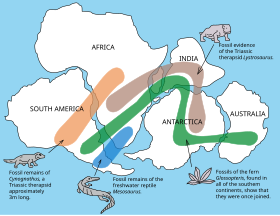Doctor Omega
Member: Rank 10
Evidence of existence

The distribution of fossils across the continents is one line of evidence pointing to the existence of Pangaea.
Fossil evidence for Pangaea includes the presence of similar and identical species on continents that are now great distances apart. For example, fossils of the therapsid Lystrosaurus have been found in South Africa, India and Antarctica, alongside members of the Glossopteris flora, whose distribution would have ranged from the polar circle to the equator if the continents had been in their present position; similarly, the freshwater reptile Mesosaurus has been found in only localized regions of the coasts of Braziland West Africa.[19]
Additional evidence for Pangaea is found in the geology of adjacent continents, including matching geological trends between the eastern coast of South America and the western coast of Africa. The polar ice cap of the Carboniferous Period covered the southern end of Pangaea. Glacial deposits, specifically till, of the same age and structure are found on many separate continents that would have been together in the continent of Pangaea.[20]
Paleomagnetic study of apparent polar wandering paths also support the theory of a supercontinent. Geologists can determine the movement of continental plates by examining the orientation of magnetic minerals in rocks; when rocks are formed, they take on the magnetic properties of the Earth and indicate in which direction the poles lie relative to the rock. Since the magnetic poles driftabout the rotational pole with a period of only a few thousand years, measurements from numerous lavas spanning several thousand years are averaged to give an apparent mean polar position. Samples of sedimentary rock and intrusive igneous rockhave magnetic orientations that are typically an average of the "secular variation" in the orientation of magnetic north because their remanent magnetizations are not acquired instantaneously. Magnetic differences between sample groups whose age varies by millions of years is due to a combination of true polar wander and the drifting of continents. The true polar wander component is identical for all samples, and can be removed, leaving geologists with the portion of this motion that shows continental drift and can be used to help reconstruct earlier continental positions.[21]
The continuity of mountain chains provides further evidence for Pangaea. One example of this is the Appalachian Mountains chain, which extends from the southeastern United States to the Caledonides of Ireland, Britain, Greenland, and Scandinavia.

The distribution of fossils across the continents is one line of evidence pointing to the existence of Pangaea.
Fossil evidence for Pangaea includes the presence of similar and identical species on continents that are now great distances apart. For example, fossils of the therapsid Lystrosaurus have been found in South Africa, India and Antarctica, alongside members of the Glossopteris flora, whose distribution would have ranged from the polar circle to the equator if the continents had been in their present position; similarly, the freshwater reptile Mesosaurus has been found in only localized regions of the coasts of Braziland West Africa.[19]
Additional evidence for Pangaea is found in the geology of adjacent continents, including matching geological trends between the eastern coast of South America and the western coast of Africa. The polar ice cap of the Carboniferous Period covered the southern end of Pangaea. Glacial deposits, specifically till, of the same age and structure are found on many separate continents that would have been together in the continent of Pangaea.[20]
Paleomagnetic study of apparent polar wandering paths also support the theory of a supercontinent. Geologists can determine the movement of continental plates by examining the orientation of magnetic minerals in rocks; when rocks are formed, they take on the magnetic properties of the Earth and indicate in which direction the poles lie relative to the rock. Since the magnetic poles driftabout the rotational pole with a period of only a few thousand years, measurements from numerous lavas spanning several thousand years are averaged to give an apparent mean polar position. Samples of sedimentary rock and intrusive igneous rockhave magnetic orientations that are typically an average of the "secular variation" in the orientation of magnetic north because their remanent magnetizations are not acquired instantaneously. Magnetic differences between sample groups whose age varies by millions of years is due to a combination of true polar wander and the drifting of continents. The true polar wander component is identical for all samples, and can be removed, leaving geologists with the portion of this motion that shows continental drift and can be used to help reconstruct earlier continental positions.[21]
The continuity of mountain chains provides further evidence for Pangaea. One example of this is the Appalachian Mountains chain, which extends from the southeastern United States to the Caledonides of Ireland, Britain, Greenland, and Scandinavia.





